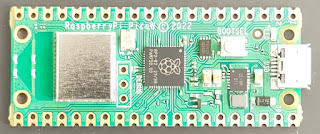Seven secrets of the Raspberry Pi Pico's success
The Pi Pico sold well; the Pico W has sold out several times since its launch.
With two million units planned for production this year, the Pico shortage will be temporary, but it's a sign that the new Pico W is going to repeat the amazing success of the original Raspberry Pi.
 |
| Pico W |
Why is it selling so well?
What's the secret?
Yesterday I jointed a group of friendly and knowledgeable enthusiasts for an online meeting of the Melbourne MicroPython Meetup.
It's not just a user group. Damien George gave a talk about the Rapsberry Pi Pico W. Damien is the creator of MicroPython, and he was responsible for the MicroPython port with Wifi support. The software was available on the day that the Pico W launched.
In the discussion that followed, several of us speculated about the secret sauce that made the Pico/Pico W so successful.
We concluded that there was no single factor, but that several features combined to make them so attractive.
Seven key features
What helped to catapult the Pico and Pico W to instant success?
First: the Raspberry Pi brand. With over 40 million Pis in the hands of Makers, Programmers, Learners, Teachers and Entrepreneurs, the Raspberry Pi name is widely known, respected and trusted.
Second: Community. the Pico family is supported by a huge Raspberry Pi community of Makers, Hackers, Journalists and Vendors.
On the day of its launch companies like Pimoroni, Adafruit and the Pi Hut offered the Pico W for sale and announced their own add-on products. The Pico W sold quickly.
By the next day enthusiasts had started to share their exploration of the Pico W!
Tom's Hardware publicised the product from the day of its launch and was quick to share projects as they were announced.
The July 2022 issue of the MagPi magazine has articles about Pico projects, and reviews of newly announced third party products.
Third: Great documentation, available at launch. Raspberry Pi's documentation is written by Alasdair Allen. He's uniquely qualified. He's a been a physicist, a hardware hacker and a journalist. His documentation is readable, clear and accurate, and he's quick to respond to feedback.
Fourth: Great software, available from the start.
With a full-featured, well-documented MicroPython port available from day one, the Pico W made it really easy for us to explore its potential.
 |
| Pico W strip |
Picos are available in quantity, in strip packaging, as is the RP2040 chip on which they are based.
Sixth: PIO (Programmable I/O) is an amazing feature of both the original Pico and the W.
PIO has enabled all sorts of capabilities; an HDMI interface, a VGA interface, and other specialist protocols, all implemented in software.
Seventh: Availability. While the Pico W has sold out a couple of times, stocks have quickly been replenished. Global chip shortages have impacted the availability of many products, including the Raspberry Pi Model 4, but the Pico has been essay to find online.
What are the Pico's competitors?
- Boards from other manufacturers that use the same chip - the RP2040. Boards are available from dozens of vendors, including Adafruit, Pimoroni and Arduino. Many of these have great extra features, but most cost significantly more than the $4/$6 of the Pico and Pico W.
- Boards from the Arduino family. The Arduino has a large and loyal following, but the original products lack the memory to support MicroPython, and more recent products are significantly more expensive.
- Boards based on the ESP 8266/32. These have a large following, and they are available at a very competitive price. I'm sure they will continue to hold a significant share of the market, but their market is fragmented and the boards attract much less media coverage than the Pico.



Comments
Post a Comment